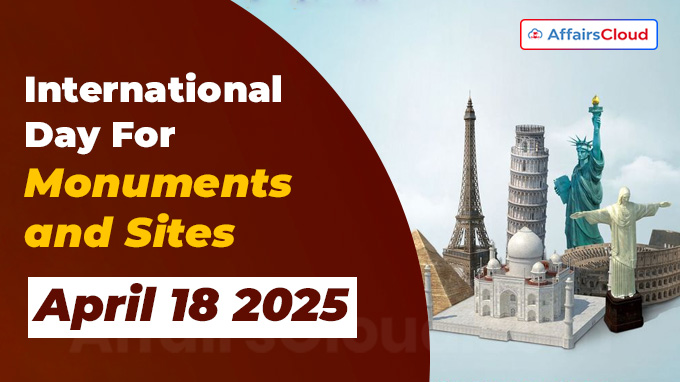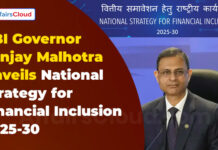 The International Day for Monuments and Sites (IDMS), also known as World Heritage Day, is observed annually across the world on April 18 to raise awareness about the importance of preserving cultural and historical heritage.
The International Day for Monuments and Sites (IDMS), also known as World Heritage Day, is observed annually across the world on April 18 to raise awareness about the importance of preserving cultural and historical heritage.
- The day encourages global citizens to appreciate the rich legacy passed down through generations, shaping national identities and fostering unity.
Theme:
i.The theme for IDMS 2025 is “Heritage under Threat from Disasters and Conflicts: Preparedness and Learning from 60 years of ICOMOS Actions.”
ii.This theme highlights the challenges faced by heritage sites due to natural calamities and human conflicts while emphasizing the role of preparedness and conservation efforts.
iii.The theme for IDMS is annually proposed by the International Council for Monuments and Sites (ICOMOS).
Background:
i.Establishment: IDMS was established in 1982 by ICOMOS.
ii.UNESCO Approval: In 1983, the United Nations Educational, Scientific and Cultural Organization (UNESCO) approved the observance of IDMS during its 22nd General Conference.
iii.First Observation: The first IDMS was observed in 1983.
About World Heritage Convention:
i.The World Heritage Convention, adopted by UNESCO in 1972, provides guidelines for identifying, protecting, and preserving sites of outstanding universal value.
- India ratified the convention in 1977.
ii.As of October 2024, the World Heritage List(WHL) includes 1,223 sites (952 cultural, 231 natural, and 40 mixed).
- A total of 196 countries have joined the convention.
India’s Contribution to World Heritage:
India has 43 World Heritage Sites(WHS), with the latest addition being “Moidams: The Mound-Burial System of the Ahom Dynasty” from Assam, inscribed in July 2024.
- The journey began in 1983 with the inclusion of Agra Fort(Agra, Uttar Pradesh, UP), Taj Mahal(Agra), Ajanta Caves(Aurangabad district, Maharashtra), and Ellora Caves(Near Aurangabad).
- India also has 62 sites on UNESCO’s Tentative List, awaiting official recognition.
Government Initiatives for Heritage Conservation:
1.Retrieval of Antiquities:
The Archaeological Survey of India (ASI) has successfully retrieved 655 antiquities from foreign countries between 1976 and 2024, with 642 recovered since 2014.
2.Adopt a Heritage Scheme:
- Launched in 2017 and revamped as Adopt a Heritage 2.0 in 2023, this initiative encourages private and public entities to develop facilities at protected monuments using Corporate Social Responsibility (CSR) funds.
- As of now, 21 Memorandums of Understanding (MoUs) have been signed between ASI and partner organizations.
3.Hosting the 46th World Heritage Committee Session:
- The Ministry of Culture(MoC), successfully hosted the 46th Session of the World Heritage Committee(WHC) in New Delhi, Delhi from July 21 to 31, 2024.
4.Conservation of Monuments of National Importance:
- India has 3,697 monuments and archaeological sites declared as nationally important.
- The ASI ensures conservation while providing amenities like pathways, signages, benches, and accessibility for differently-abled visitors.
5.Revival and Redevelopment of Key Heritage Sites:
Several projects have enhanced heritage tourism, including:
- Kashi Vishwanath Corridor (Varanasi, UP)
- Mahakaal Lok (Ujjain, Madhya Pradesh, MP)
- Maa Kamakhya Corridor (Guwahati, Assam)
- Chardham Road Project (improving connectivity to sacred sites)
- Kartarpur Corridor (facilitating pilgrim access)
6.Digital Initiatives for Heritage Preservation:
- Must See Portal (asimustsee.nic.in): Showcases 100+ prominent monuments, providing historical details, access information, and panoramic views.
- National Mission on Monuments and Antiquities (NMMA): Established in 2007, it has documented 12.3 lakh antiquities and 11,406 heritage sites.
- Indian Heritage in Digital Space (IHDS): Uses digital technology to preserve and present India’s cultural legacy.
7.Recognition of Classical Languages:
In 2024, the Government of India(GoI) granted classical language status to Assamese, Marathi, Pali, Prakrit, and Bengali, bringing the total to 11 classical languages.
8.New Museums and Heritage Experiences:
- Archaeological Experiential Museum (Vadnagar, Gujarat): Inaugurated on January 16, 2025, this Rs 298 crore project spans 12,500 square meter(sqm) and displays 5,000+ artifacts from Vadnagar’s 2,500-year history.
- Humayun’s Tomb World Heritage Site Museum (New Delhi): Opened in 2024, this 100,000 sqft museum offers an immersive journey through Mughal architecture and conservation efforts.
9.Literary Heritage on MOWCAP Register:
Three Indian literary works were added to the 2024 Memory of the World Committee for Asia and the Pacific (MOWCAP) Regional Register:
- Ramcharitmanas
- Panchatantra
- Sahrdayāloka-Locana
About International Council on Monuments and Sites (ICOMOS):
President– Teresa Patricio (Belgium)
Headquarters– Paris, France
Established – 1965




